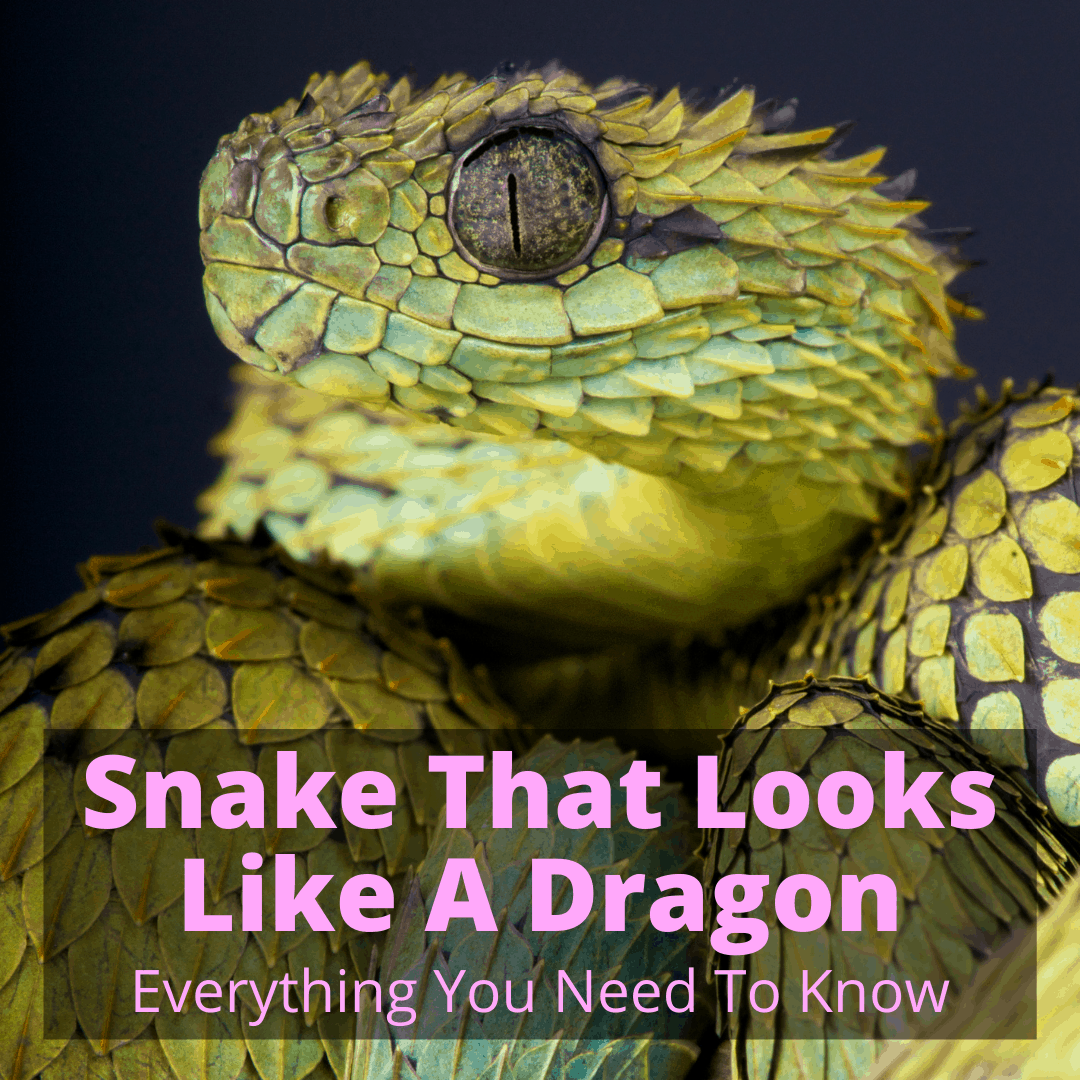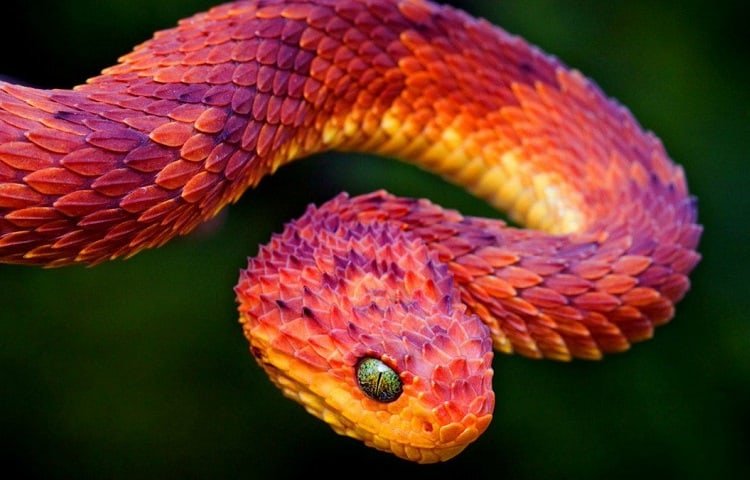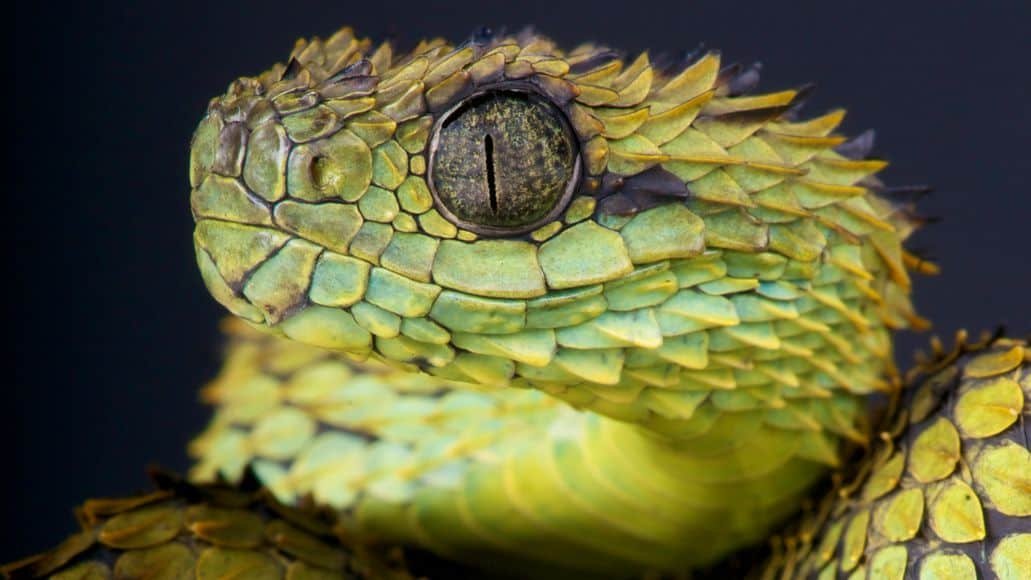
You probably saw a photo of it and were left wondering what exactly it is.
That’s only natural.
After all, it is a very unusual looking snake, with scales that are best described as hairy.
Well, I have some disappointing news for you: it’s not a dragon.
But it is a highly unusual (and highly dangerous) snake. Let’s take a closer look and answer any questions you may have.
Table of Contents
Snake That Looks Like A Dragon
The snake that resembles a dragon is the Atheris hispida, more commonly referred to as the Bush Viper.
It is a venomous snake species. Its scientific name stems from the Greek words meaning hairy and tailed. It is these traits that result in the dragon-like appearance.
What Does It Look Like?

Bush Vipers are unique and cool looking. They are relatively small in size, with adults ranging in length from 40 to 78 cm.
They have a triangular head (commonly found in venomous snakes) and a broad snout. Their body is firm and slender.
The eyes are large, and their elliptical pupils are enchanting. Their long, hollow fangs can make even grown men wince.
Members of this species come in a variety of colors, like green and blue. There are even some red ones, although those are rare.
Interestingly, a snake’s color may change throughout life from birth to adulthood. Its beautiful color often leads people to believe it’s a member of a different species.
What is most noticeable are the Bush Viper’s scales. They are heavily keeled, especially on the head, and have a somewhat hairy look to them. Very few snakes have keeled scales like this species.
Where Is It Found?
You can find Bush Vipers in tropical sub-Saharan Africa with the exception of Southern Africa. It is a very particular species and chooses only rain forests to inhabit—far away from humans.
The Bush Viper once had a much wider distribution around sub-Saharan Africa, but the population is now declining due to habitat destruction. Unfortunately, not much is known about the population numbers due to the remote location.
What’s Special About It?

This snake is so rare that there’s no antivenom for its bite. However, Echis antivenom can sometimes work on Bush Viper bites.
While Bush Vipers usually go for small prey, their venom has killed humans in the past. Stay a few feet back if you come across one in the African bush!
Reports of Bush Viper bites are low, however, because they are so secluded.
Not much is known about their venom except that it’s toxic and can cause pain, swelling, and internal bleeding (which is lethal). Of course, toxicity varies and depends on the snake, the location of the bite, and even the weather and altitude.
Interestingly, viper venom is being used to develop therapies and possibly even cures for many diseases.
When Was It Discovered?
Raymond Ferdinand Laurent (1917-2005) discovered Atheris hispida in 1955 in Central Africa. Specifically, in the Democratic Republic of the Congo, south-west Uganda, and west Kenya.
While there were many species of Bush Viper, Laurent was the scientist who discovered the rough-scaled Bush Viper–the one that resembles a dragon.
Laurent was a Belgian herpetologist. He specialized in African and South American amphibians and reptiles. With more than 200 scientific articles and book chapters published and several species named after him, he is a highly respected figure in the scientific community.
What Does It Eat?

Bush Vipers LOVE to eat! And combined with all the laying around they do, this species is actually prone to obesity. An obese snake! Have you ever heard of such a thing?
They usually prey upon small amphibians, lizards, rodents, birds, and even other snakes. Some may even eat frogs.
For the most part, they are not super picky eaters and scarf down whatever is around. You may think these snakes aren’t an essential part of the ecosystem, but they do an excellent job of keeping the rodent population down, and with it disease.
Bush Vipers don’t work that hard for their food. They wait patiently—on the rainforest floor or hanging from a tree branch—and ambush their prey when it enters the striking zone.
Most of its prey are not able to get away from its lightning-fast strike. Talk about being in the wrong place at the wrong time!
Can You Keep It As A Pet?
Bush Vipers are not usually kept as pets because they are venomous and unpredictable. Unfortunately, they are common among the exotic or black market pet trade and owners will often have them defanged in an attempt to lessen the danger.
If you are curious about the Bush Viper, it is best to go and look at one in the zoo.
Bush Vipers do surprisingly well in captivity–needing only access to trees to hang from. Their caretakers should keep in mind that they are rather gluttonous creatures. It is easy to overfeed them!
In the wild, these snakes live on average ten years. However, a Bush Viper in the zoo would live longer because risk factors such as predation, disease, and diet are controlled.
What Are Their Habits?

Bush Vipers are arboreal, which means they live in trees, although they can sometimes be found slithering around on the rainforest floor.
Whether it spends time in high or low places depends on the season as well as the time of day. It prefers lowlands during the dry season, and during the wet season, it prefers the high grounds.
It hides in dense vegetation on the rainforest floor during the day, and early in the morning, it leisurely hangs from tree branches (thanks to its prehensile tail).
Bush Vipers are also nocturnal, which means they are active during the night, and their hunting and feeding habits reflect this.
When And How Do They Mate?
Bush Vipers are ovoviviparous, which means the embryos develop inside eggs that remain in the mother’s body until they are ready to hatch. You are probably familiar with this process but didn’t know it had such a fancy name!
Mating takes place during the wet season (October and November) and then the little baby snakes are born in March and April. However, if you want to breed these snakes in captivity, you can manipulate the humidity level and control when you want them to breed.
What Are Its Weaknesses?
Unlike other vipers, Bush Vipers do not have infrared sensing (heat sensing). Instead, they rely on vision, olfactory, and vibratory senses to detect prey. They actually have quite good vision (for a snake).
Dragon-Like Snake: Final Thoughts
The snake that looks like a dragon is the bush viper. It is a highly venomous snake found in parts of Africa.
It is a beautiful snake with an unusual look, but it is not suitable as a pet at all. It is aggressive and potentially deadly and there is no anti-venom for its venom. Enjoy it is a zoo, not your home.

Leave a Reply